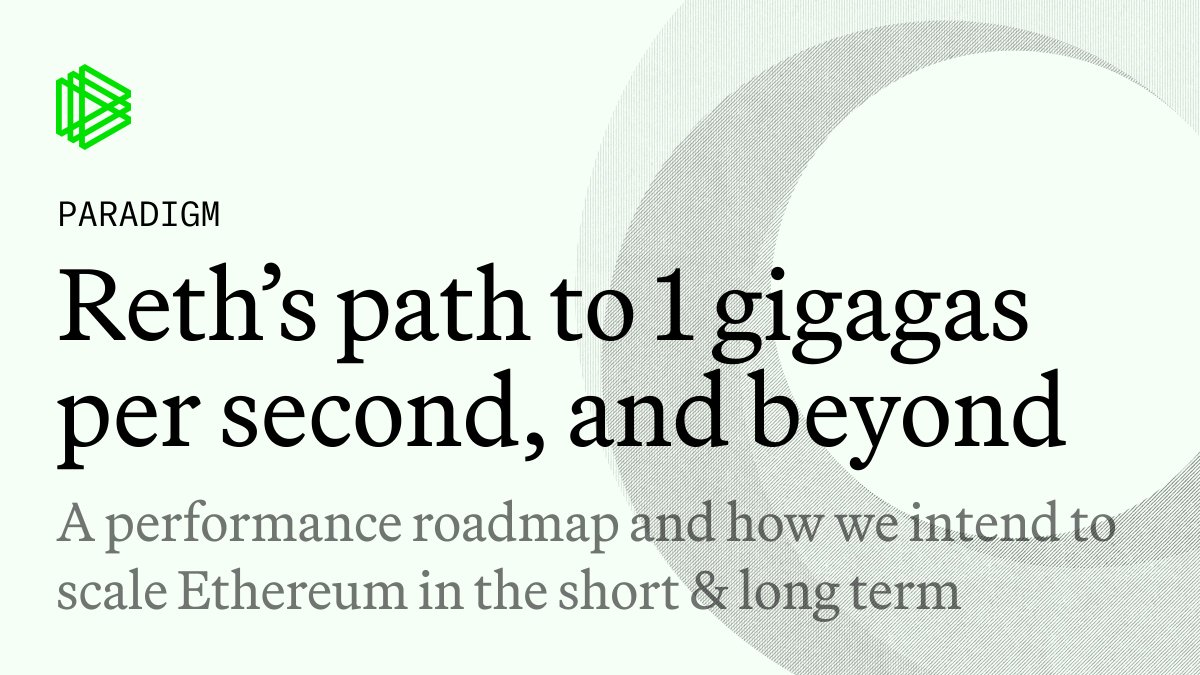We have made great strides in the world of blockchain scaling in the last 10 years.
It’s time to go further.
Reth’s path to 1 gigagas per second, and beyond…where we present our roadmap for scaling Ethereum.
It’s time to go further.
Reth’s path to 1 gigagas per second, and beyond…where we present our roadmap for scaling Ethereum.

To start, we must stop using Transactions Per Second as a performance metric and use more nuanced metrics.
We propose to the EVM community to adopt Gas Per Second (GPS) as a standard metric, and start seriously exploring multi-dimensional pricing.
ethresear.ch/t/draft-positi…
We propose to the EVM community to adopt Gas Per Second (GPS) as a standard metric, and start seriously exploring multi-dimensional pricing.
ethresear.ch/t/draft-positi…
So what is the gas per second on various chains today?
A quick survey shows most chains at <10megagas per second, with Binance's chains leading the charge.
A quick survey shows most chains at <10megagas per second, with Binance's chains leading the charge.

Reth in recent benchmarks does 100-200mgas/s, including senders recovery, execution and merklization on live syncing.
But how can we do better?
1. Vertical scaling: Make each machine faster and more efficient
2. Allow splitting workloads across multiple machines.
But how can we do better?
1. Vertical scaling: Make each machine faster and more efficient
2. Allow splitting workloads across multiple machines.

In our research, we present 3 vertical scaling methods that will be rolled out in Reth over 2024, which we hope will at least 10x our performance benchmark, enabling us to hit the 1+ gigagas per second mark for rollups.
We also identify ways to go beyond that in the cloud.
We also identify ways to go beyond that in the cloud.

JIT / AOT EVM: Reduce the interpreter overhead, and run native code.
We have exciting results to show here in the next weeks.
We have exciting results to show here in the next weeks.

Parallel EVM: Multi-threading to enable execution of more transactions.
We identify at least two flavors for this, which are different for historical and live sync. We are working with multiple external teams to integrate their approaches in Reth.
We identify at least two flavors for this, which are different for historical and live sync. We are working with multiple external teams to integrate their approaches in Reth.

The state commitment takes >75% of Reth's live sync time today. Every % point in state root performance gained here matters.
This is the most complex and exciting topic, so I'll just go ahead and share the entire section of the blog here.


This is the most complex and exciting topic, so I'll just go ahead and share the entire section of the blog here.


I think there's a TON of work to do on the state root, probably the most important problem in crypto performance.
I wrote about this recently.
I wrote about this recently.
https://twitter.com/gakonst/status/1777306306598089094
Going beyond a single machine, there's 2 things we're doing:
1. Create great abstractions for spinning up rollups alongside the node.
2. Create great abstractions for splitting the node into multiple machines.
We want to create the Kubernetes moment for serverless crypto infra.
1. Create great abstractions for spinning up rollups alongside the node.
2. Create great abstractions for splitting the node into multiple machines.
We want to create the Kubernetes moment for serverless crypto infra.

We have a lot of open questions:
How can Reth help with other clients' perf? How do we price the avg -> worst case perf degradation? How do we manage the tension between L1 and L2 potentially diverging?
We don't know the answers, but we want to collaborate with people on them.
How can Reth help with other clients' perf? How do we price the avg -> worst case perf degradation? How do we manage the tension between L1 and L2 potentially diverging?
We don't know the answers, but we want to collaborate with people on them.
We will move the needle on scaling Ethereum.
If you’re excited about contributing to breaking the 1gigagas/s barrier for EVM Rollups, reach out to georgios@paradigm.xyz.
paradigm.xyz/2024/04/reth-p…
If you’re excited about contributing to breaking the 1gigagas/s barrier for EVM Rollups, reach out to georgios@paradigm.xyz.
paradigm.xyz/2024/04/reth-p…
• • •
Missing some Tweet in this thread? You can try to
force a refresh
















